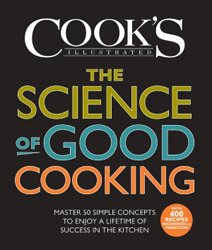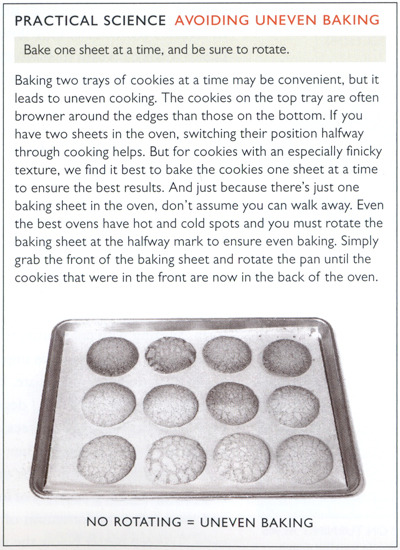The Science of Good Cooking

Basic principles
I’ve learned more about cooking from this hefty volume than from reading or watching anything else.
There are other fine books about the science of cooking, including Harold McGee’s previously reviewed classic On Food and Cooking, but this big book is by far the most practical and helpful. While McGee’s is authoritative and complete, this one is better organized for your average cook. The science is condensed into 50 principles, and each easy-to-remember principle is illustrated by half a dozen tested recipes. If you can master these 50 you’ll have the equivalent of a culinary degree.
An example of a principle would be: Salting vegetables removes liquid. You’ll hear the evidence why this is true, what difference it makes in dishes, and how to apply it to any recipe in the future. Every claim is tested by experiments run by the nerd chefs at Cook’s Illustrated, so that you have full command of the idea and its exceptions. Although this book is jam packed with “best recipes” this is not a traditional cookbook: it is more of a cooking course. The teaching is a model of clarity and insight.
12/19/12Excerpt
The way you cut an onion affects its flavor. To prove the point, we took eight onions and cut each two different ways: pole to pole (with the grain) and parallel to the equator (against the grain). We then smelled and tasted pieces from each onion cut each way. The onions sliced pole to pole were clearly less pungent in taste and odor than those cut along the equator.
*
Perhaps just as important as cookware material is the pan shape and size. Crowd four chicken breasts into a 10-inch pan and they will steam; space them out in a 12-inch pan and they will brown.
*
Salty Marinades Work Best
Marinating is often regarded as a cure-all for bland, chewy meat. Years of testing have taught us that while many marinades can bump up flavor, most will never turn a rough cut tender. Well, not without the right ingredient. What's the secret to a marinade that can add complexity to steak, chicken and pork and enhance juiciness? You guessed it: salt.
*
Gentle Folding Stops Tough Quick Breads
As we learned in concept 39, yeast breads depend on a well-developed gluten structure to rise properly. Gluten also gives bread its resilient, chewy texture. In contrast, quick breads (such as banana bread), as well as muffins and pancakes, can be ruined by excess development of gluten. That's because tenderness--not chewiness--is the goal.
*
Two Leaveners Are Often Better than One
The advent of chemical leaveners, such as baking soda and baking powder, in the 19th century made it easier for cooks to bake at home. No need to rely on fickle yeast in order to make a cake. Chemical leaveners are quick and reliable. But they are also confusing. Some recipes rely on baking powder, some on baking soda, and many on both. Why do you need two leaveners in something as simple as a cookie that doesn't even rise all that much?
*
The Science of Good Cooking The Editors of America's Test Kitchen and Guy Crosby 2012, 504 pages $26








